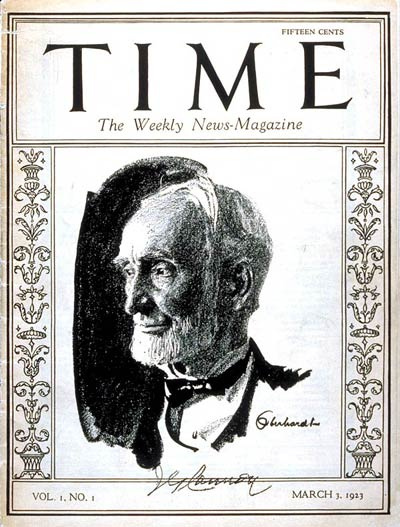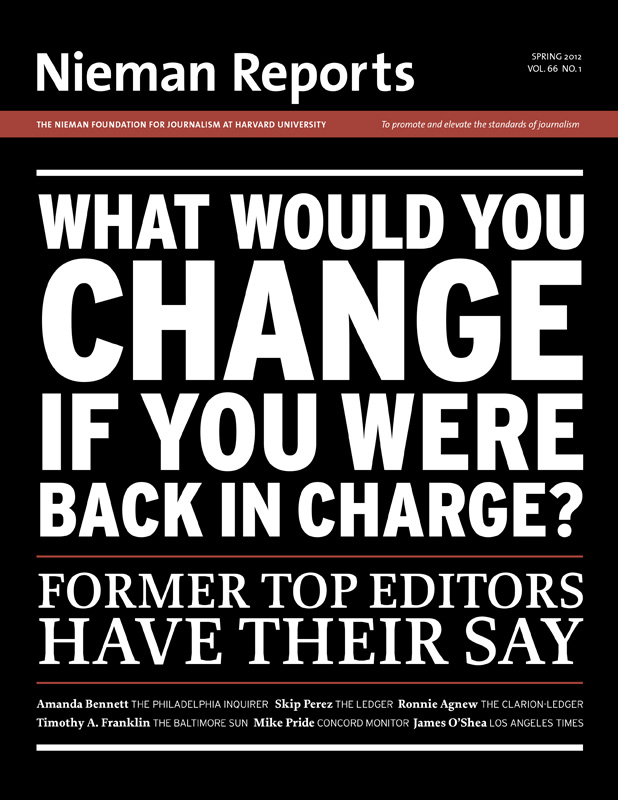In chronicling the evolution of news, the Nieman Journalism Lab tracks start-ups, identifies innovations, and shares lessons about how quality journalism can thrive in the Internet age. Not every success can be duplicated in another market or niche but by highlighting best practices in online journalism, the Lab aims to help foster a sustainable future. Like the reporting you'll find on an everyday basis at www.niemanlab.org, the pieces summarized below offer insights about what's working. —Joshua Benton, NF '08, Lab Director
Aggregation is deep in journalism's DNA
By David Skok, 2012 Nieman Fellow and managing editor of Global News Online
 When Time magazine debuted in March of 1923, its 29 pages were full of advertisements sold against content aggregated from The Atlantic, The Christian Science Monitor, and the New York World, among others. Today the magazine is a respected source of original reporting.
When Time magazine debuted in March of 1923, its 29 pages were full of advertisements sold against content aggregated from The Atlantic, The Christian Science Monitor, and the New York World, among others. Today the magazine is a respected source of original reporting.
That transformation might be good to keep in mind as aggregators, including The Huffington Post and BuzzFeed, begin creating their own content. They are following a trajectory that can be explained by Harvard business professor Clayton M. Christensen's theory of disruption. As he explained in his book, "The Innovator's Dilemma," new entrants in an industry start at the bottom and move up the value chain by taking market share from their bigger, older and frequently complacent competitors. That's what Japanese automakers did in the 1980's; they started with cheap subcompacts and now they make Lexuses.
How a tightly paywalled, social-media-ignoring, anti-copy-paste, gossipy news site became a dominant force in Nova Scotia
By Tim Currie, online journalism professor at University of King's College
AllNovaScotia.com charges $360 a year for exclusive coverage of the business and political elite of Canada's most populous Atlantic province. Yet nearly 6,000 subscribers—primarily the province's movers and shakers—keep coming back for its mix of speculation and business news, including a regular feature on "Who's Suing Whom." The site doesn't bother with multimedia or social media and rarely links. Reporters scour court records, property transfers, and building permits, consistently scooping their print rival. Subscriptions account for 80 percent of the 10-year-old site's revenue. It's not a model that will work everywhere, but it demonstrates that the right content can be king.
Having two brands isn't better than having one
By Joshua Macht, group publisher of the Harvard Business Review Group
The Boston Globe's new two-site strategy aims to capture the best of the free and paid Web, but in doing so, the paper risks diluting its brand. That's a lesson the Harvard Business Review Group learned in reverse.
Two years ago, the Review's separate websites (one free, one paid) were merged under a single URL and editorial team. With the magazine and website providing a more consistent experience, it's been easier to build readership. The result was a 20 percent increase in newsstand sales and 135 percent growth in unique visitors to the site.
Looking to Europe for news-industry innovation: A Three-Part Series
By Ken Doctor, researcher and analyst for Outsell
While the news about many American media companies is gloomy, a number of European news organizations have turned a profit from the Web:
The Wall Street Journal covers Fashion Week fashionably, finding uses for Pinterest and Instagram
By Andrew Phelps, staff writer at the Nieman Journalism Lab
 To cover one of the most glamorous annual events in New York City, the staid Wall Street Journal capitalized on the growing popularity of Instagram and Pinterest. The former is a photo-sharing app that lets users apply filters to images, the latter an invitation-only social message board.
To cover one of the most glamorous annual events in New York City, the staid Wall Street Journal capitalized on the growing popularity of Instagram and Pinterest. The former is a photo-sharing app that lets users apply filters to images, the latter an invitation-only social message board.
The Journal assigned nine reporters to Fashion Week and sent them into the field with iPhones, Instagram accounts, and orders to file as many photos as possible. Posting photos on the two services reached an audience far beyond typical Journal readers.
Aggregation is deep in journalism's DNA
By David Skok, 2012 Nieman Fellow and managing editor of Global News Online
 When Time magazine debuted in March of 1923, its 29 pages were full of advertisements sold against content aggregated from The Atlantic, The Christian Science Monitor, and the New York World, among others. Today the magazine is a respected source of original reporting.
When Time magazine debuted in March of 1923, its 29 pages were full of advertisements sold against content aggregated from The Atlantic, The Christian Science Monitor, and the New York World, among others. Today the magazine is a respected source of original reporting.That transformation might be good to keep in mind as aggregators, including The Huffington Post and BuzzFeed, begin creating their own content. They are following a trajectory that can be explained by Harvard business professor Clayton M. Christensen's theory of disruption. As he explained in his book, "The Innovator's Dilemma," new entrants in an industry start at the bottom and move up the value chain by taking market share from their bigger, older and frequently complacent competitors. That's what Japanese automakers did in the 1980's; they started with cheap subcompacts and now they make Lexuses.
How a tightly paywalled, social-media-ignoring, anti-copy-paste, gossipy news site became a dominant force in Nova Scotia
By Tim Currie, online journalism professor at University of King's College
AllNovaScotia.com charges $360 a year for exclusive coverage of the business and political elite of Canada's most populous Atlantic province. Yet nearly 6,000 subscribers—primarily the province's movers and shakers—keep coming back for its mix of speculation and business news, including a regular feature on "Who's Suing Whom." The site doesn't bother with multimedia or social media and rarely links. Reporters scour court records, property transfers, and building permits, consistently scooping their print rival. Subscriptions account for 80 percent of the 10-year-old site's revenue. It's not a model that will work everywhere, but it demonstrates that the right content can be king.
Having two brands isn't better than having one
By Joshua Macht, group publisher of the Harvard Business Review Group
The Boston Globe's new two-site strategy aims to capture the best of the free and paid Web, but in doing so, the paper risks diluting its brand. That's a lesson the Harvard Business Review Group learned in reverse.
Two years ago, the Review's separate websites (one free, one paid) were merged under a single URL and editorial team. With the magazine and website providing a more consistent experience, it's been easier to build readership. The result was a 20 percent increase in newsstand sales and 135 percent growth in unique visitors to the site.
Looking to Europe for news-industry innovation: A Three-Part Series
By Ken Doctor, researcher and analyst for Outsell
While the news about many American media companies is gloomy, a number of European news organizations have turned a profit from the Web:
- Finland's Sanoma has been effective at bundling digital and print subscriptions to its Helsinki daily, enticing a third of its print subscribers to pay for digital access.
- Norway's Schibsted, the world's eighth-largest news company, has been publishing classified ads online since 1999 and now has a Craigslist-like hold on the market in Europe.
- Switzerland's Gossweiler Media has begun licensing its model—digital first, an intensely local focus, and integrated advertising—across Europe.
The Wall Street Journal covers Fashion Week fashionably, finding uses for Pinterest and Instagram
By Andrew Phelps, staff writer at the Nieman Journalism Lab
 To cover one of the most glamorous annual events in New York City, the staid Wall Street Journal capitalized on the growing popularity of Instagram and Pinterest. The former is a photo-sharing app that lets users apply filters to images, the latter an invitation-only social message board.
To cover one of the most glamorous annual events in New York City, the staid Wall Street Journal capitalized on the growing popularity of Instagram and Pinterest. The former is a photo-sharing app that lets users apply filters to images, the latter an invitation-only social message board.The Journal assigned nine reporters to Fashion Week and sent them into the field with iPhones, Instagram accounts, and orders to file as many photos as possible. Posting photos on the two services reached an audience far beyond typical Journal readers.



